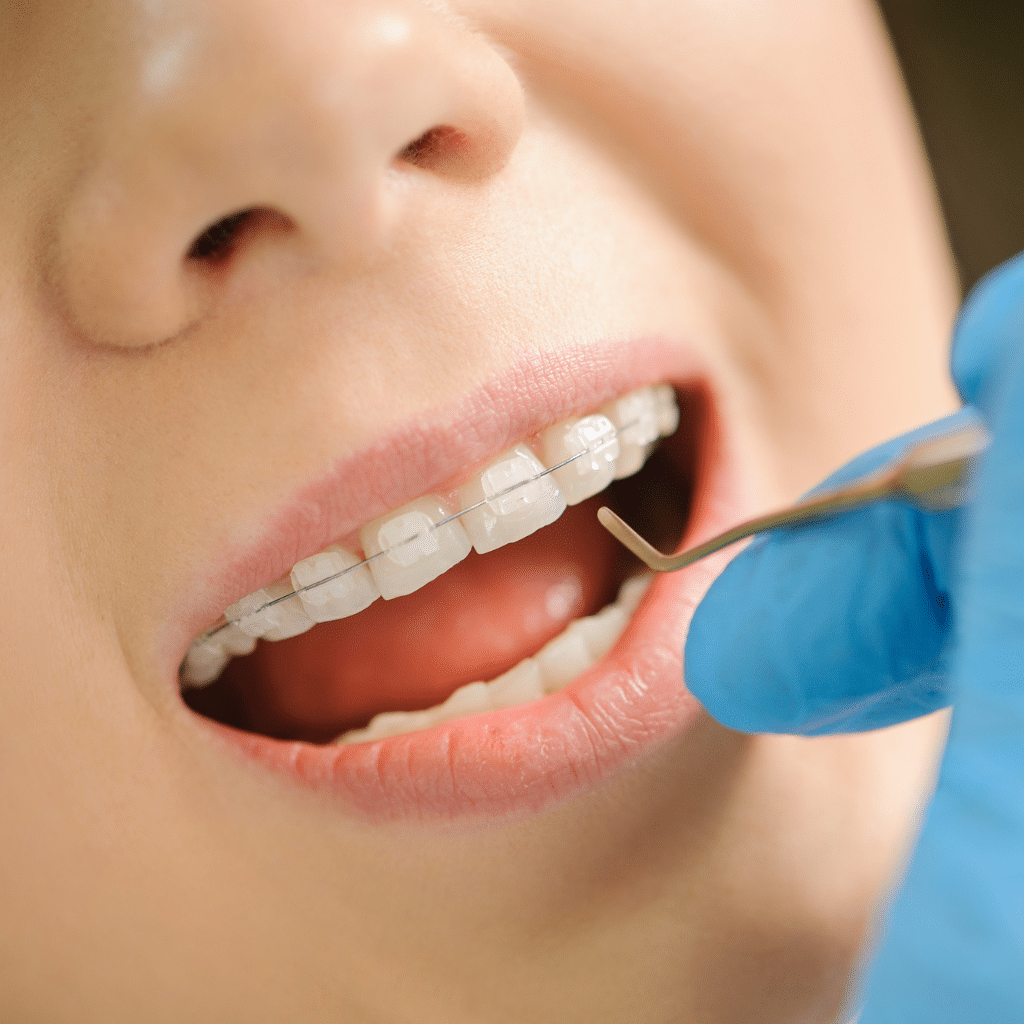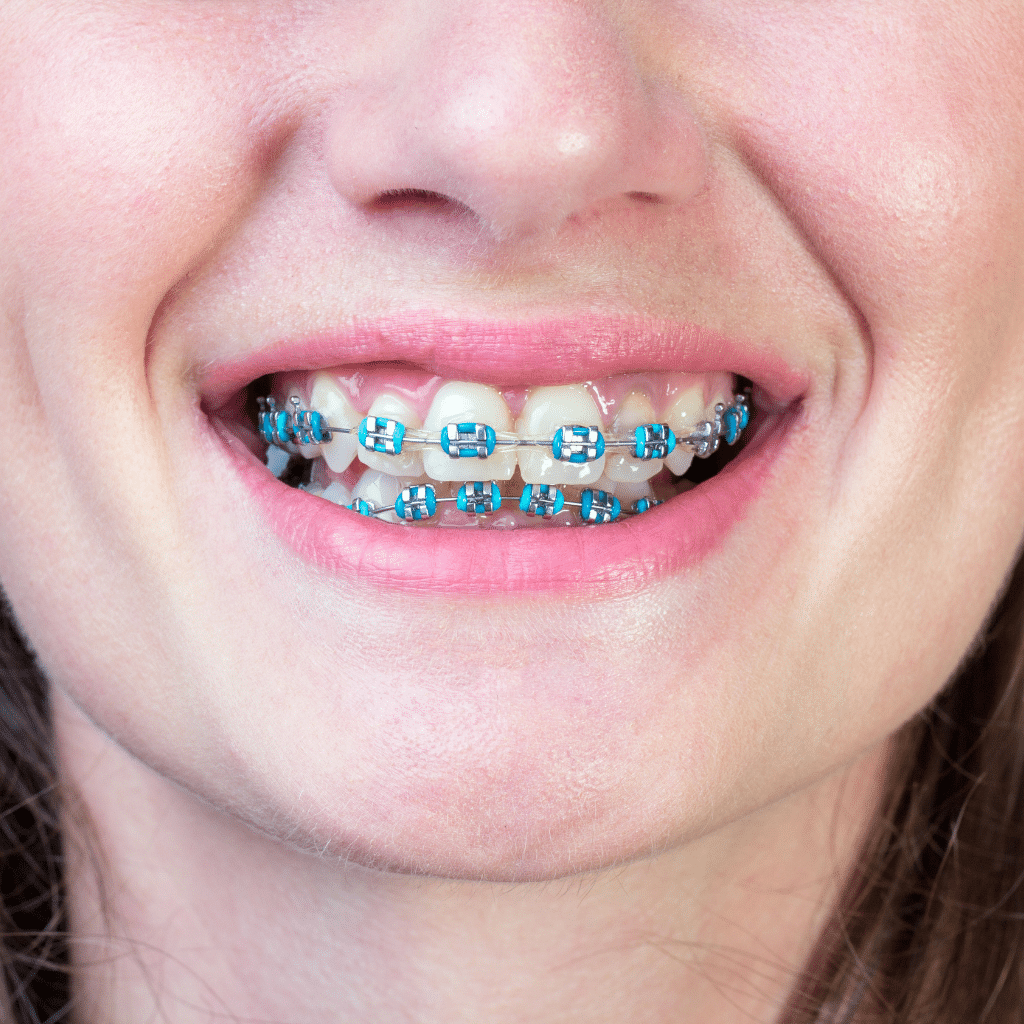Dental braces encompass a variety of types, each tailored to specific orthodontic needs. Traditional metal braces offer robust solutions for complex misalignments. Ceramic braces blend with tooth color for a subtler appearance. Lingual braces are positioned invisibly at the teeth’s interior surfaces. Self-ligating braces enhance comfort with reduced friction, while Invisalign aligners provide a removable, nearly invisible option. Each type possesses distinctive advantages and considerations, inviting further exploration of their specialized benefits.
Key Takeaways
- Traditional metal braces are durable and effective for complex dental misalignments, using metal brackets and wires to exert continuous pressure.
- Ceramic braces blend with natural tooth color, offering a less visible alternative while effectively addressing dental issues similar to those of metal braces.
- Lingual braces are affixed to the interior of teeth, providing a discreet solution for moderate dental misalignments with custom fitting.
- Self-ligating braces reduce friction and facilitate smoother tooth movement, often leading to shorter treatment durations and enhanced patient comfort.
- Invisalign braces use custom-made, clear aligners for mild to moderate alignment issues, offering a nearly invisible and removable option.
What Are the Different Types of Dental Braces?
The landscape of orthodontic treatment offers a diverse array of dental braces, each catering to specific aesthetic and functional needs.
Traditional metal braces remain a robust option due to their durability and effectiveness, while ceramic braces offer a more discreet alternative with similar benefits.
Additionally, advancements in orthodontics have introduced lingual braces for concealed alignment, self-ligating braces for reduced treatment times, and Invisalign for those seeking a nearly invisible solution.
Traditional Metal Braces: A Classic Choice and Their Advantages
Among the various orthodontic treatments available, traditional metal braces remain a steadfast option due to their proven efficacy in correcting a wide array of dental misalignments.
As a common type of braces, they utilize metal brackets and wires to exert continuous pressure that gradually moves teeth into proper alignment. This orthodontic treatment is particularly efficient for addressing complex dental issues, including severely misaligned teeth.
Traditional metal braces offer considerable advantages in dental care, providing consistent and predictable outcomes. Their robust construction endures the forces required to straighten teeth effectively, making them the preferred choice for many orthodontists.
Despite advancements in orthodontic technology, metal braces for teeth remain a practical solution for patients seeking a reliable method to achieve ideal dental alignment.
Understanding Ceramic Braces and Their Benefits
Ceramic braces, composed of a ceramic material, offer a less conspicuous alternative to traditional braces, appealing particularly to adults concerned with aesthetic considerations. These dental braces blend with the natural tooth color, reducing visibility.
Functionally, they address dental problems similar to those of metal or ceramic options, providing effective alignment solutions. Among the types of braces available, ceramic braces are slightly less durable than metal due to the fragility of the ceramic material.
The benefits, however, include a lower profile appearance, making them a preferred choice for those prioritizing discretion. While they perform comparably to traditional metal braces, the choice between metal and ceramic typically hinges on visual preference and lifestyle needs.

An Overview of Lingual Braces
Surprisingly, lingual braces remain one of the lesser-known yet highly effective orthodontic options available today.
These dental braces are distinctive due to their placement behind the teeth, providing a discreet solution compared to other types of braces for teeth. Utilizing brackets and wires similar to traditional metal or ceramic braces, lingual braces are uniquely positioned at the back of the teeth, rendering them virtually invisible during everyday interactions.
As dental appliances, they are suitable for individuals with moderate dental misalignments seeking an inconspicuous treatment. The complexity of installing lingual braces necessitates a skilled orthodontist, as each bracket must be custom-fitted to conform to the lingual surface.
Consequently, lingual braces offer an innovative alternative within the spectrum of different types of dental braces.
What Are Self-Ligating Braces?
Self-ligating braces represent a modern advancement in orthodontic treatment, distinguished by their use of a specialized bracket system that eliminates the need for elastic or metal ties traditionally used in braces.
This type of brace is designed to reduce friction and facilitate smoother tooth movement, offering an effective alternative to metal braces for individuals with moderate dental problems. Choosing the right type of braces can greatly impact dental health and treatment efficiency.
Key advantages of self-ligating braces include:
- Reduced Treatment Time: These braces work efficiently, often leading to shorter treatment durations compared to traditional braces.
- Improved Comfort: The absence of ties reduces pressure on teeth, enhancing patient comfort.
- Easier Maintenance: Simplified cleaning and maintenance compared to other brace types.
Considering their benefits, self-ligating braces are a viable option among different types of braces.
Exploring Invisalign Braces
Invisalign braces have emerged as a popular orthodontic solution, particularly appealing due to their virtually invisible appearance and removable nature. As a type of dental braces, Invisalign is ideal for mild to moderate dental alignment issues. This system employs a series of custom-made, clear aligners that gradually shift teeth into the desired position. Unlike traditional braces, Invisalign braces offer a discreet treatment option, allowing individuals to maintain the natural color of their teeth while receiving dental services. In addition, the removable feature facilitates the effortless ability to clean the teeth, meeting extensive dental needs.
| Feature | Invisalign Braces |
|---|---|
| Appearance | Virtually Invisible |
| Suitability | Mild to Moderate Dental Issues |
| Maintenance | Easy to Clean Due to Removability |
This innovative approach represents a significant advancement among different types of teeth braces.
How to Choose the Right Type of Braces for Your Needs?
Selecting the appropriate type of dental braces involves a thorough evaluation of various factors, including aesthetic preferences, budget constraints, and specific orthodontic requirements.
Consulting with a dental professional is essential to guarantee that the chosen braces align with the individual’s dental anatomy and treatment objectives.
Additionally, comparing the structural and aesthetic differences between metal and clear braces can provide valuable insights into which option may offer the most effective and comfortable solution for the patient.

Factors to Consider When Selecting Braces for Teeth
When contemplating the myriad options for dental braces, what critical factors should be considered to guarantee a suitable choice? Understanding the types of dental braces available is paramount.
- Material Composition: Evaluate whether metal braces, ceramic braces, or other types offer the best type of braces for individual needs.
- Age Consideration: The appropriate age for braces can influence the decision.
- Clinical Requirements: Evaluating the complexity of the dental situation determines the most suitable braces available.
Some may require more robust solutions, whereas others might find many types of braces sufficient.
Consulting with a Dental Professional
Understanding the various factors that influence the selection of dental braces underscores the importance of professional consultation. A dental professional evaluates the patient’s orthodontic needs to determine the appropriate type of brace.
Different braces are available, including metal and ceramic options, each with distinct advantages. Metal braces are the most common due to their durability and effectiveness. In contrast, ceramic braces are less conspicuous.
Self-ligating braces use a specialized clip instead of elastics, offering a reduction in friction and potentially shorter treatment duration. Braces are also categorized by cost, with some being less expensive than traditional braces. Additionally, patients must consider what to eat after having braces to ensure proper care and comfort during treatment.
Consulting with the best dental clinic guarantees personalized guidance in selecting the ideal braces for individual requirements, balancing aesthetics, efficiency, and budgetary considerations.
Comparing Metal and Ceramic Braces
Choosing between metal and ceramic braces requires a nuanced understanding of their respective characteristics and suitability for individual orthodontic needs.
Metal braces are traditionally constructed from high-grade stainless steel, offering robustness and cost-effectiveness. Ceramic braces, composed of polycrystalline or monocrystalline alumina, provide an aesthetic advantage due to their tooth-colored appearance.
Here are key considerations:
- Durability: Metal braces are more resilient to fracture, making them suitable for complex corrections.
- Aesthetics: Ceramic braces blend with natural teeth, appealing to those concerned with appearance during treatment.
- Cost: Typically, metal braces are more economical compared to ceramic options, which may feature higher material costs.
Ultimately, the choice hinges on the patient’s orthodontic requirements, aesthetic preferences, and financial considerations.
What Are the Benefits of Different Types of Braces?
In evaluating the benefits of various orthodontic solutions, lingual braces offer the advantage of being positioned on the interior surface of the teeth, facilitating a discreet treatment option without compromising efficacy.
Similarly, Invisalign braces provide an alternative through clear aligners that can be removed as necessary, allowing for greater flexibility and ease of oral hygiene maintenance.
Both options present significant advantages regarding aesthetic appeal and patient comfort, making them highly desirable for those prioritizing subtlety in orthodontic treatment.
Discreet Treatment: Exploring the Benefits of Lingual Braces
Lingual braces offer a unique approach to orthodontics by affixing brackets and wires to the lingual (tongue-facing) surfaces of the teeth. This positioning renders them virtually invisible from the outside, making them an ideal choice for those seeking inconspicuous treatment.
The benefits of lingual braces include:
- Aesthetic Superiority: Lingual braces remain hidden, thereby maintaining the natural appearance of the patient’s smile during realignment.
- Custom Fit: Each bracket is custom-made to conform precisely to the contours of the patient’s teeth, enhancing both comfort and efficacy.
- Thorough Treatment: Unlike some other discreet options, lingual braces are capable of addressing complex dental malocclusions, offering a thorough orthodontic solution.
This alternative appeals to individuals prioritizing both effectiveness and discretion.
The Perks of Invisalign Braces
While traditional braces have long been a staple in orthodontic treatment, Invisalign has emerged as a popular alternative for its unique blend of effectiveness and subtlety.
Invisalign utilizes a series of custom-made, clear aligners crafted from thermoplastic material, providing a nearly invisible appearance. This system offers significant advantages, including improved oral hygiene due to the removable nature of the aligners, allowing for easier brushing and flossing.
Additionally, the absence of metal brackets and wires reduces the likelihood of oral abrasions and discomfort. Invisalign treatment is often associated with reduced chair time, as adjustments are minimal compared to traditional braces.
Moreover, the digital treatment planning employed by Invisalign guarantees precise, predictable outcomes, enhancing patient satisfaction. This innovative approach represents a modern solution for orthodontic correction.
Are There Different Types of Braces for Adults?
When considering orthodontic treatment for adults, a range of options is available, each tailored to address specific dental and lifestyle needs.
Special considerations such as periodontal health, bone density, and aesthetic preferences play essential roles in selecting the appropriate type of braces.
Among these options, Invisalign presents a significant alternative due to its clear aligner technology, offering a discreet and flexible solution for many adult patients.

Options for Adult Orthodontic Treatment
For adults considering orthodontic treatment, a variety of sophisticated options are available to address both functional and aesthetic concerns. The decision to undergo orthodontic correction is influenced by factors such as the severity of dental misalignment, lifestyle, and cosmetic preferences.
Adults may choose from several advanced orthodontic solutions:
- Clear Aligners: These removable, transparent devices offer a discreet way to straighten teeth, utilizing incremental adjustments to achieve desired alignment without the visibility of traditional braces.
- Lingual Braces: Custom-fitted to the interior surfaces of the teeth, lingual braces provide the mechanical strength of conventional braces while remaining hidden from view, ideal for patients prioritizing aesthetic discretion.
- Ceramic Braces: Composed of tooth-colored materials, ceramic braces function similarly to metal braces but blend with natural teeth, offering an aesthetically pleasing alternative for visible orthodontic appliances.
Special Considerations for Adult Braces
Adults require tailored orthodontic solutions due to specific dental health conditions, aesthetic preferences, and lifestyle considerations. Traditional metal braces, ceramic braces, lingual braces, and self-ligating braces each present distinct advantages and limitations.
Metal braces provide robust alignment capabilities but may lack discretion. Ceramic braces, although less conspicuous, might incur higher costs and necessitate meticulous oral hygiene to prevent staining. Lingual braces offer invisibility, yet demand expert orthodontic proficiency for effective placement. Self-ligating braces reduce friction and treatment duration but may not suit severe misalignments.
Adult patients must consider factors such as periodontal health, bone density, and treatment duration to guarantee ideal orthodontic outcomes. Professional consultation is essential for informed decision-making.
Exploring Invisalign Braces for Adults
The appeal lies in their discreet nature and technological advancements.
Invisalign aligns teeth using custom-made, clear aligners that are virtually invisible, offering aesthetic advantages over traditional metal braces. Additionally, they provide a removable alternative, allowing for easier oral hygiene and dietary flexibility.
A deeper examination reveals three critical benefits:
- Aesthetic Appeal: The transparency of Invisalign aligners makes them a preferred choice for adults concerned with the visual impact of orthodontic treatments.
- Comfort and Convenience: The smooth, custom-fit aligners minimize irritation and can be removed for eating and cleaning.
- Predictability and Efficiency: Advanced digital imaging allows precise treatment planning, often resulting in shorter treatment durations compared to conventional methods.
Conclusion
In conclusion, the diverse array of dental braces, including traditional metal, ceramic, lingual, and clear aligners, offers tailored orthodontic solutions for varying needs. Each type presents distinct advantages, such as aesthetic appeal, comfort, and efficacy in correcting dental misalignments. Selecting the appropriate braces necessitates a thorough evaluation of individual dental conditions, lifestyle preferences, and treatment goals. For adults, advancements in orthodontics guarantee discreet and effective options are available, facilitating improved oral health and alignment outcomes.


